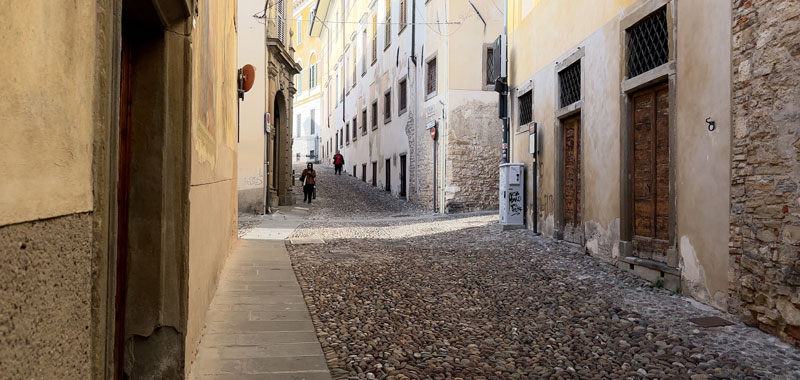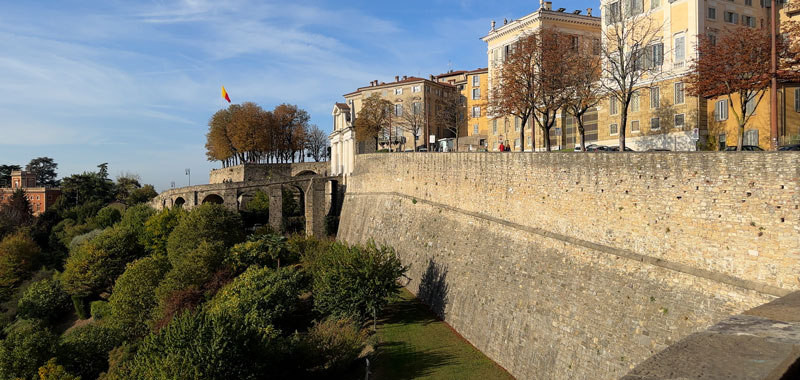
We're taking the second walking tour of our visit along picturesque narrow lanes from Porta Sant’Alessandro to Piazza Vecchia on the back roads. Turning away from the main lane of the city and walk along Piazza Mascharoni, that soon becomes Via San Salvatore. Typical of the paving here, one can choose between smooth flagstones or the pebble cobblestones.
You might notice some students walking here at the gated entrance onto the University of Bergamo campus, which has numerous buildings distributed throughout the town. You'll probably see more students out walking, especially in these back lanes. The university has 16,000 students in Bergamo. It was founded in 1968 and is already a regional leader in research and education.

It's a school that accepts students from all over the world creating a diverse and enriching learning environment, making a delightful place to study with a peaceful atmosphere amidst these historic sites.

Via Salvecchio is an impressive side lane connecting with the town's main street. In some courtyards you'll see lovely buildings and gardens, and along the way, there are some interesting little shops where you’ll encounter a glimpse of local life with residents going about their daily routines, off the beaten track. We are away from the visiting crowd, exploring little alleyways, fun to look at.

A narrow alleyway connects from Via Salvecchio to Via Arena, the main street of this part of town. It's fun how the streets generally do not follow a straight line. There are little angles, and sometimes they are curved, so there is a little mystery as to what's up ahead. That's always part of the game when you're walking in these little alleyways.
Misericordia, a charitable institution founded in 1265, completed their important Baroque building in 1664 with a lovely cloister that also houses the Museo Donizettiano, displaying the works of the renowned local composer Gaetano Donizetti. Another institution on Via Arena is the Episcopal Seminary of Bergamo, which accommodates the vocation of young people who feel oriented towards the path of priesthood.

It's called Via Arena because it was the location of the ancient Roman amphitheater that was once here. In the Middle Ages it played a significant role in the development of Bergamo Alta. You can see how much fun it is to venture beyond the main squares and lanes and discover Bergmo's hidden gems. Get lost in the charming labyrinth of narrow streets, showcasing hidden piazzas, little shops and unique sites tucked away.
Take a right turn, walking down Via Simone Mayr, another charming street nestled in the heart of town, passing medieval townhouses with their characteristic stone facades and alongside buildings with Renaissance influences. Notice again the attractive and functional street paving of brick and stone cobbles providing secure footing. Thanks to ongoing restoration and maintenance, many of Bergamo’s old buildings look like they are new.

One of the most important features that Bergamo is famous for is the great fortified wall that runs all the way around the city, built by the Venetians for defense back in the 16th-century, and has been designated a UNESCO World Heritage site, with its green parks surrounding the town.

To get the best view of the wall, walk from Via Simone Mayr a block down to Porta San Giacomo, one of the four magnificent gateways through the Venetian walls and a great place for grand vistas. The gate was built in 1592 by the important Venetian architect, Vincenzo Scamozzi, with a design incorporating classical architecture with the Italian Renaissance.
The wall extends along both sides of the gate with a huge stone ramp that comes out the front, which had originally been a wooden drawbridge over the dry moat. Now it's a pedestrian path that can take you all the way down to the lower town.

From here you get outstanding panoramic views of the surrounding city and the Bergamo Valley, extending off in the distance. You'll see the lower town below, which we will visit at the end. These walls were built by Venice, which controlled Bergamo for three centuries, from 1428 to 1797 even though it's 240 kilometers away.

Venice was a powerful city-state with a vast empire that extended throughout much of the eastern Mediterranean. Construction required demolition of several hundred homes and buildings, which upset the population so much that Venice had to send in an army of 15,000 to put down the protests. Ironically, after all that work, the walls were never attacked or involved in any battles. Perhaps their ominous presence discouraged any outside forces from attempting an invasion.

Now there are peaceful gardens here, and the promenade along the wall has become a very popular park, a place for some jogging or walking and healthy outdoor exercise, or maybe just kick back and sit on a bench and enjoy the view. After all, there are really no parks or patches of greenery when you're in the historic center. The upper town is mostly stone and brick with a beautiful collection of historic buildings, especially some of those big churches.
After walking along this scenic wall and park for two hundred meters, return back into the old town alleys, perhaps along Via Rosate, which will bring you back towards Piazza Vecchia.
These lanes form an intricate maze of narrow streets with tall buildings and old churches all around them in a little tangle of narrow alleys and smaller piazzas off the beaten track. It's quite a place to wander and get a little bit lost and then find your way out again with very little effort.

Arriving at Piazza Padre Reginaldo Giuliani, look up at the tall tower and rounded arches at the back of the Basilica of Santa Maria Maggiore, where you can see the Romanesque style of building that dates back to 1140.
On the east end of Piazza Duomo you get a look at the headquarters for the University of Sciences Letters and Arts of Bergamo. Next to it, a historic fountain is connected to a cistern that supplied water to this part of town.

Extending out from Piazza Duomo to the east is Via Gaetano Donizetti, named after Bergamo’s most famous composer, who created about 70 operas. There are some schools in this neighborhood, including a university building for the Department of Linguistics. This road continues down to Piazza Mercato delle Scarpe, already visited in the first walk.
One more fascinating nearby site to see at the end of this walk is an outdoor washing fountain, Lavatoio di Via Lupo.
.jpg)
Most houses in the upper town did not have running water inside the houses in the old days. So this basin was built at the end of the 1800s to provide a washing facility. The water supply cistern could contain 300 cubic meters of water built below the structure and a discharge system and drainage channels that make it an amazing design model. This is one of three public washing fountains built in Bergamo to improve public hygiene, which had gotten so bad there was a cholera epidemic in 1884. The basin continued in use untill the 1950s and is currently preserved as a precious memory of the past.

Wandering along these alleys, through arches and apartment courtyards is a lovely way to explore the back streets.
Our walk ends back at Piazza Vecchia.